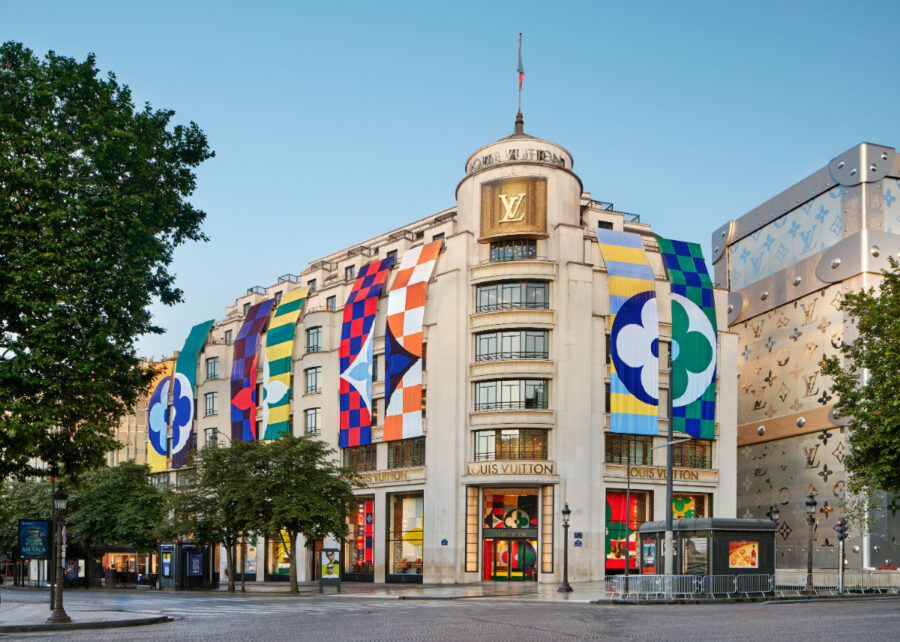
CULTURE


© CreatAR

© CreatAR
〈Expo Cultural Park Greenhouse〉は、上海万博が開催された文化公園に残る、工業用ホールの鉄骨構造を活用した、熱帯雨林や砂漠の自然を体験することのできる温室です。
一般的に温室は多くのエネルギーを要するのに対し、シミュレーションにより導き出した「単層ガラス×植物」などのさまざまなアプローチによりエネルギー効率を高めています。オーストリアのウィーンに拠点を置く国際的な建築事務所 DMAA(Delugan Meissl Associated Architects)が設計しました。
注目ポイント
- 「高密度かつ高品質な緑地の創出」という世界的な開発トレンドを反映
- 建物のテクスチャであり来館者の体験を高める、うねるガラスカーテンウォール
- 世界の自然を体験し、これからの気候に目をむけるパビリオン
(以下、DMAAから提供されたプレスキットのテキストの抄訳)
現代では、自然と親しみ、自然を知ることは、都市生活において欠かせない要素となっており、自然は建築における中心的な存在にもなっている。DMAAは近年、さまざまな温室の設計に取り組み、幅広い技術的およびデザイン的経験を蓄積してきた。
人口2,300万人を擁するメガシティである上海は、中国における都市開発および国際開発の中心となっている。

© CreatAR
人口密度の低い工業都市であった浦東(ほとう)は、その中心に万博文化公園を擁するアジア屈指の高層ビル群が立ち並ぶエリアへと発展した。一方で、上海地域は気候変動の脅威も高まっている。
深刻な大気汚染、水不足、気温上昇に直面する中、中国の指導者たちは抜本的かつ大規模な対策を模索し、解決策を見つけようとしている。これらの対策は、自然生息地の保護を目的とするだけでなく、中国の技術的および経済的取り組みを、持続可能な開発へと導くことも期待されている。

© CreatAR
このエリアにはかつて鉄鋼工場が建っており、2010年の上海万博の会場として改修され、その後万博公園に生まれ変わった。
新しい温室庭園プロジェクトの一環として、かつての工業用ホールの鉄骨構造は、この場所の記憶と重要な要素として残され、有機的な形状の温室がそれに連結されている。産業と自然、伝統と未来という2つの対立概念は、上海にとって歴史的な転換点となった。
市政府は、この中心部に位置する広大な土地を、高品質な緑地レジャーエリアに再開発することを決定した。この取り組みは、亜熱帯気候の世界最大級の都市である上海の中心市街地に、より高密度で高品質な緑地を創出するという開発トレンドを明確に反映している。

© CreatAR

© CreatAR
エネルギー効率を高める「単層ガラス×植物」のアプローチ
一般的に温室は多くのエネルギーを必要とする中で、このプロジェクトではゼロエネルギー・ビルディングを目指した。
シミュレーションの計算結果から、従来の二重ガラス窓のエネルギー効率は低く、植物への人工照明による熱損失の削減の方がより大きな影響を与えることが示された。これにより、カーテンウォールの設計において、エネルギー消費を抑制するために単層ガラス窓を採用するという革新的なアプローチが生まれた。

© CreatAR
同時に、屋根の開口部も科学的に計画されており、自然換気や受動冷却など、さまざまな省エネ手法を自由に調整して、特定の植物に最適な気候をつくり出すことができる。
展示ホールに隣接する水面は、優れた冷却効果をもたらすだけでなく、水面下に設置された太陽光発電パネルにより、温室にクリーンエネルギーを供給する。

© CreatAR
世界の自然を体験し、これからの気候に目をむけるパビリオン
〈Expo Cultural Park Greenhouse〉は、3つのパビリオンと1つのエントランス棟で構成されている。
最初のパビリオンでは、砂と石の風景で砂漠の過酷な乾燥状態を表現しており、乾燥に耐えることができる絶滅危惧種の植物が、各大陸から集められている。
これに対し、2番目のパビリオンには熱帯雨林の植物が植えられ、最後のパビリオンの垂直庭園では、多様性と回復力を備えた展示スペースを提供している。保存された産業構造物上の展望台からは、公園全体と周辺の都市を見渡すことができる。

© CreatAR
保存された産業構造物の下に位置する大規模な回廊は、プロジェクトを周辺の自然環境と統合しつつ3つのパビリオンとエントランスビルを結んでおり、温室の内部および温室間の通路のネットワークが、多様な空間体験を生み出している。
来館者は能動的に探索しながら、それぞれの空間を順に巡り、建物とさまざまな形で交流する。廊下に沿って設けられたガラスの手すりは来館者の視野を広げ、手すりに設けられたわずかな傾斜は、訪問者の探索ペースを自然に速めたり遅くしたりする。

© CreatAR
砂漠と熱帯雨林の植生における異なる水位と水の形態は、自然からインスピレーションを得たものであり、同時に気候変動による将来的な世界的な水問題を暗喩的に表現している。
それと同時に、有機的にうねるガラスカーテンウォールは、温室のファサードの主要なテクスチャであるだけでなく、人間と自然の新たな適応関係の象徴でもある。

© CreatAR

© CreatAR

© DMAA

© DMAA

© DMAA

© DMAA

© DMAA
以下、DMAAのリリース(英文)です。
Expo Cultural Park Greenhouse
Project description
The zeitgeist has shifted towards recognizing nature as the essential basis of our living environment. And nature has also moved to the heart of architecture. In recent years, as it has repeatedly addressed the specific task of greenhouse design, DMAA has developed extensive technical and cultural knowhow.With a population of 23 million, the megacity of Shanghai is the focal point of China’s urban and international development. The sparsely inhabited industrial suburb of Pudong has become home to one of Asia’s most spectacular high-rise skylines, at the heart of which the Expo Cultural Park is situated. But the Shanghai Region is also directly threatened by the consequences of unlimited growth and climate change. Given biting smogs, water shortages, and rising temperatures, the country’s leaders are looking for solutions that take the form of radical largescale steps – steps that should not only preserve natural habitats but also steer China’s technological and economic efforts in a sustainable direction.
Before its transformation into the Expo Cultural Park, the inner-city recreational area was occupied by a coal-fired power plant and a steel- works. It was then remodeled as the location for Expo 2010. As part of the project for the new Greenhouse Garden, the steel structure of a former industrial hall was used as a geometrical superstructure that was then enhanced by organically shaped pavilions. The twin dualities of industry and nature and tradition and future mark the historical turning point at which Shanghai now finds itself. The municipal administration’s decision to refunction such a huge, centrally-located piece of land as a high-quality leisure area offers clear evidence of the overall trend towards the more intense planting of the core urban zones of Shanghai, one of the largest cities in the world with a subtropical climate.
As greenhouses generally consume large amounts of energy, one particular aim of this project was to create a zero-energy building. This was achieved by the use of single glazing – a choice based on simulative calculations that showed that double glazing would be less energy efficient due to the fact that the reduction in heat loss would be more than cancelled out by the impact of the artificial lighting required by the plants. Opening windows in the perforated roof can be adjusted to permit the natural ventilation and passive cooling that creates the optimal climate for the specific plants. A pool adjacent to the pavilions not only provides cooling but also supplies energy to the greenhouse from PV panels that are located just below its surface.
The first pavilion recreates the radical aridity of the desert, with a sandy and rocky landscape that embodies the home of plants that can withstand drought yet are threatened by extinction in every continent. In contrast, the second pavilion contains the tropical vegetation of the rainforest, while the vertical flower gardens of the final pavilion offer space for travelling exhibitions. The terrace above the pavilions offers an overview of the entire park and the buildings that form the edge of the surrounding urban fabric.Between the three pavilions and the entrance building, and below the listed steel structure, a largescale circulation space integrates the project into the surrounding nature.
The network of pathways within and between the greenhouses generates new qualities. By actively exploring this network, visitors pass through each spatial sequence, experiencing a targeted interaction with the built substance. Glazed parapets reveal these guests while gentle gradients speed up or slow down their progress.
The variation in water levels between the desert and the tropical vegetation is taken from nature, while also offering a global political perspective due to the questions about the future availability of water that are being raised by climate change. In this way, the organically undulating form of the facade becomes a leitmotif for not only the internal organization but also the new adaptable relationship between humans and nature.
CATEGORY
Cultural, Landscape Design, GreenhouseADDRESS
Shanghai Expo Cultural Park – Guo Zhan
Lu Pudong Xinqu, ShanghaiCOMPETITION: 2018 (1st Price)
START OF PLANNING: 03/2019
START OF CONSTRUCTION: 01/2020
COMPLETION: 09/2024GROSS SURFACE AREA: 41.000 m²
CONSTRUCTION VOLUME: 340.000 m³
SITE AREA: 47.000 m² (within the whole Park)
HEIGHT: 35 m
NUMBER OF LEVELS: 3
NUMBER OF BASEMENTS: 1COSTS: € 300 Mio.
PROJECT MANAGER: Diogo Teixeira
PROJECT TEAM: Yue Chen, Jurgis Gecys, Thomas Peter-Hindelang, Toms Kampars, Prima Mathawabhan, Sebastian Michalski, Ernesto Mulch, Maximilian Tronnier, Toni Nachev, Marillies WedlCONSULTANTS
COORDINATION: Yiju Ding
EXECUTIVE PLANNING: SIADR Co.Ltd
STRUCTURAL ENGINEERING: Bollinger + Grohmann, ZT GmbH
ENERGY DESIGN: Transsolar Energietechnik GmbH
LANDSCAPE DESIGN: Yiju Ding
「Expo Cultural Park Greenhouse Garden」DMAA 公式サイト
https://www.dmaa.at/work/expo-cultural-park-greenhouse-garden-shanghai








